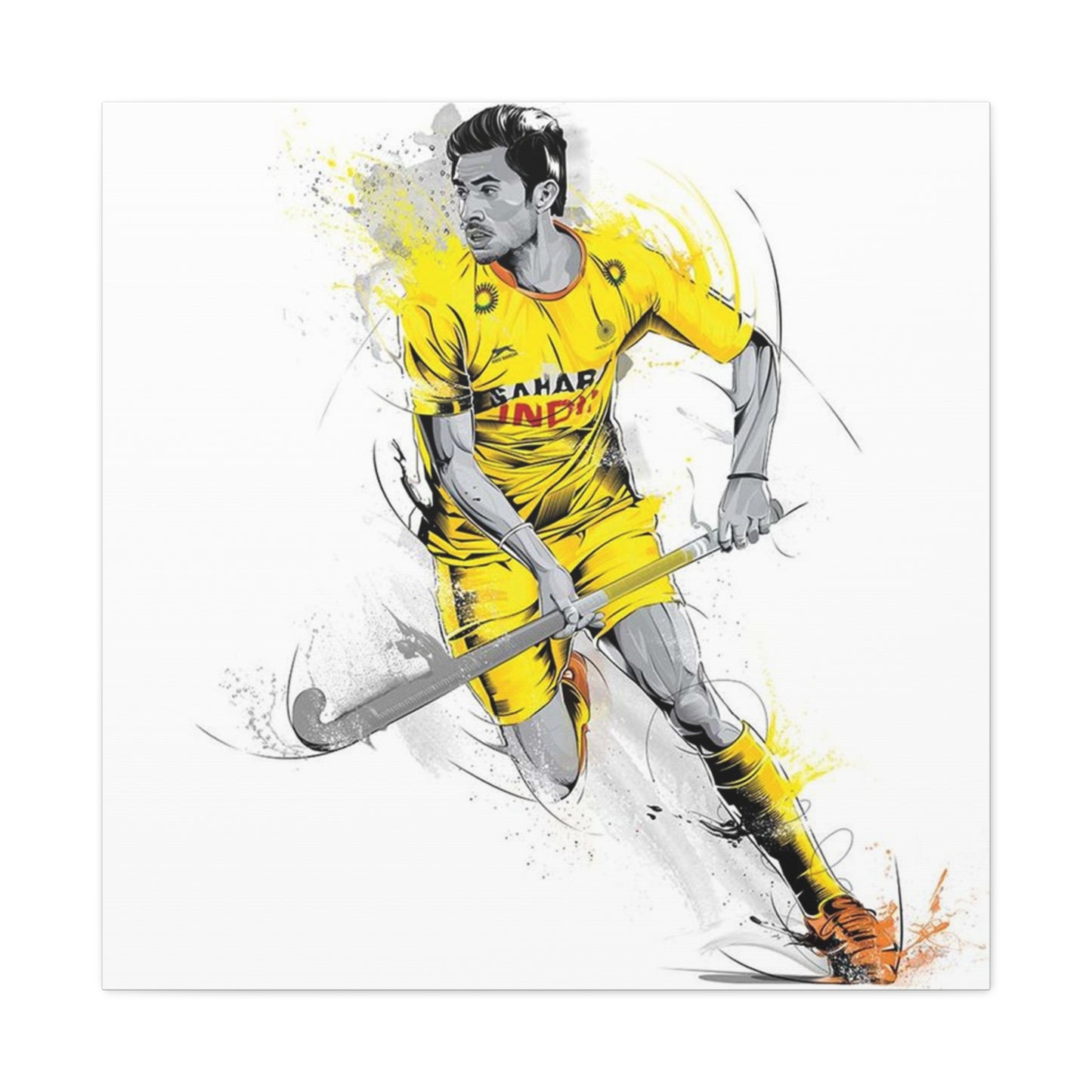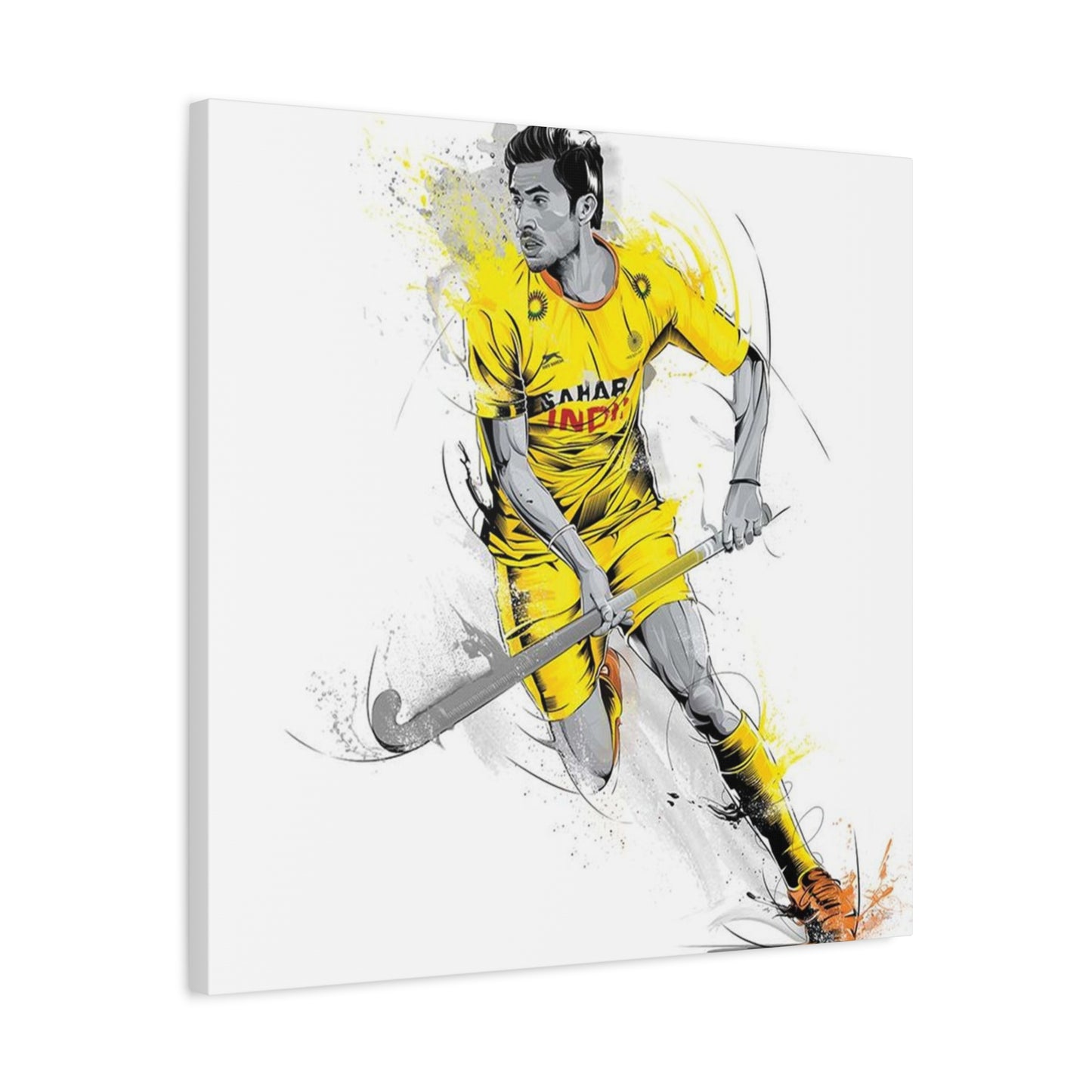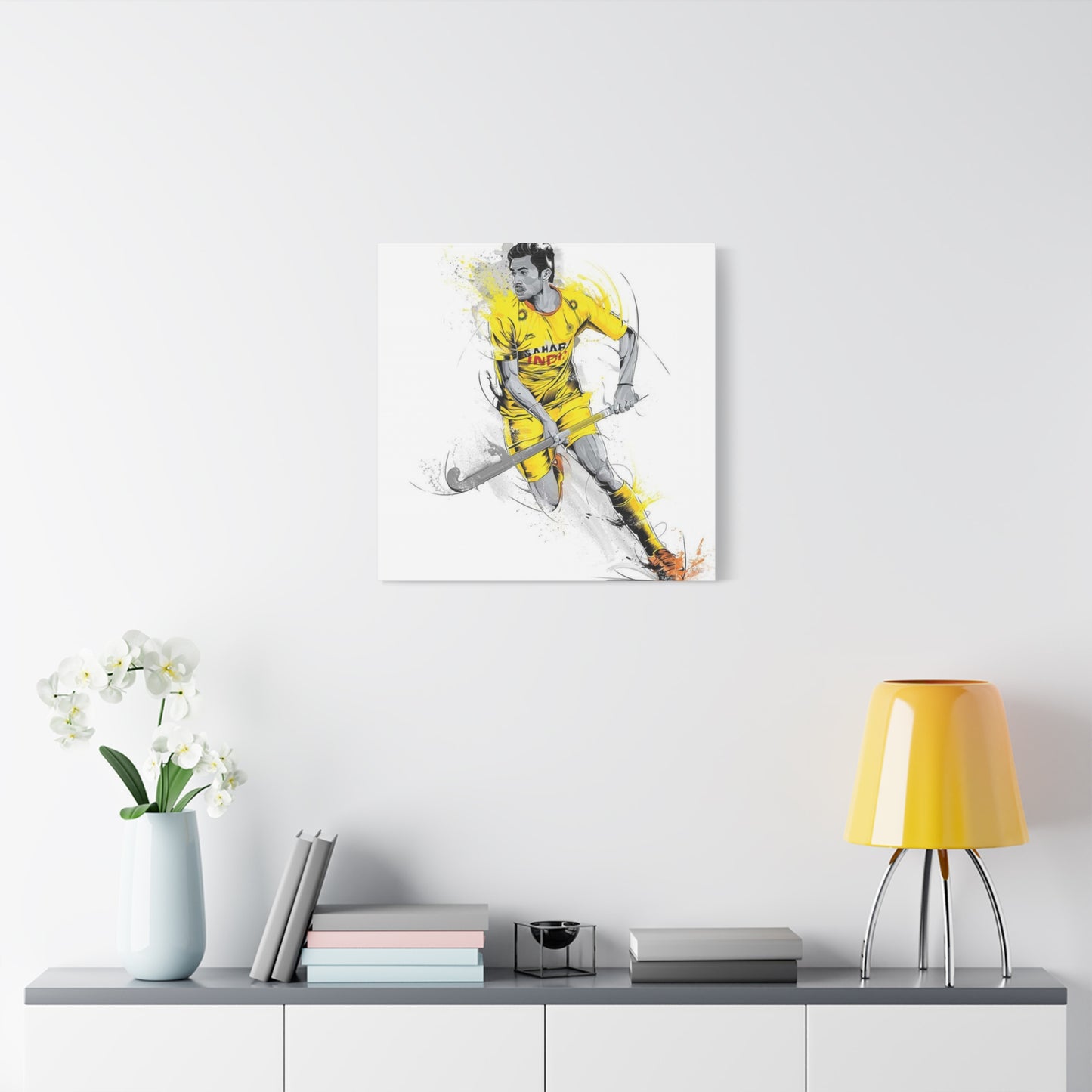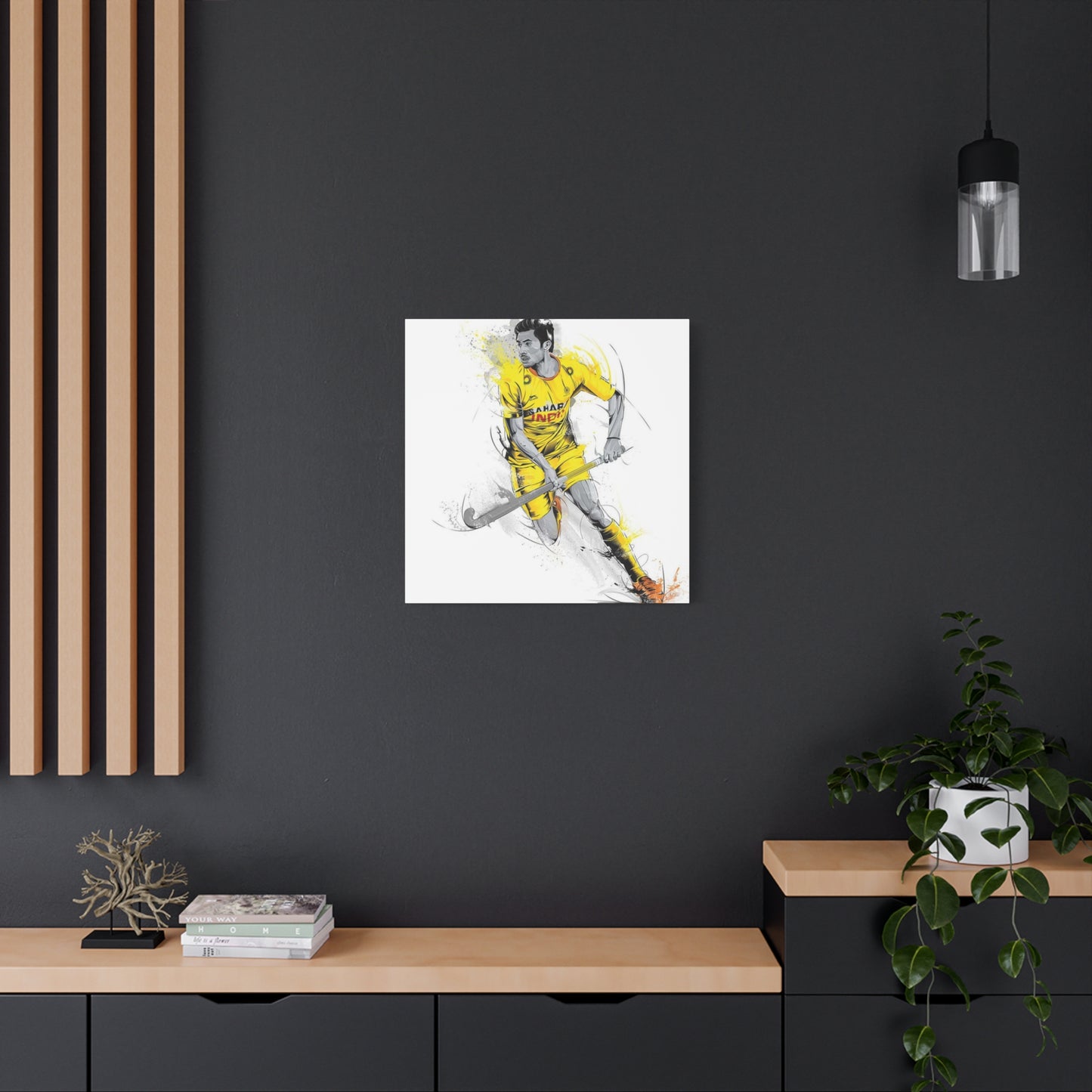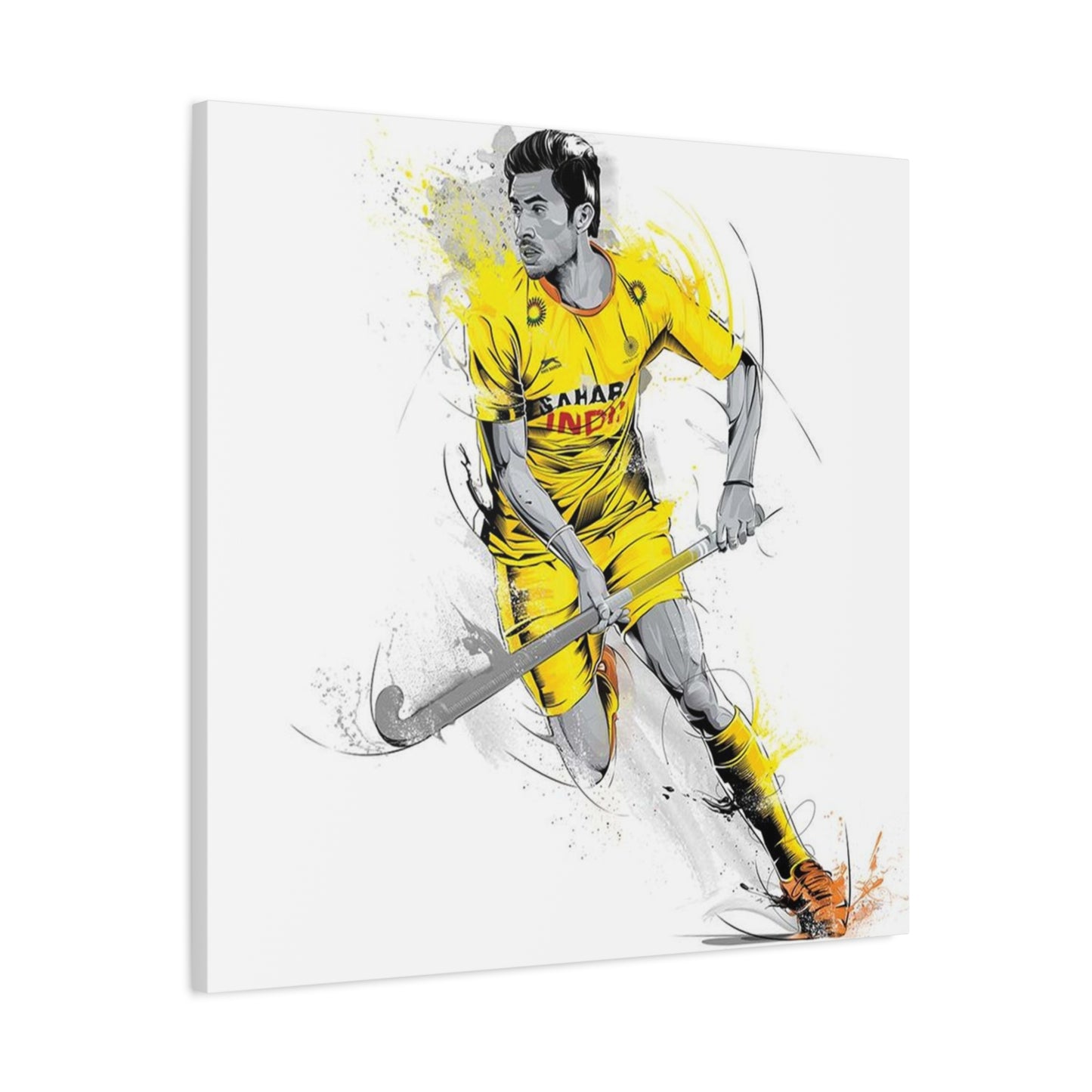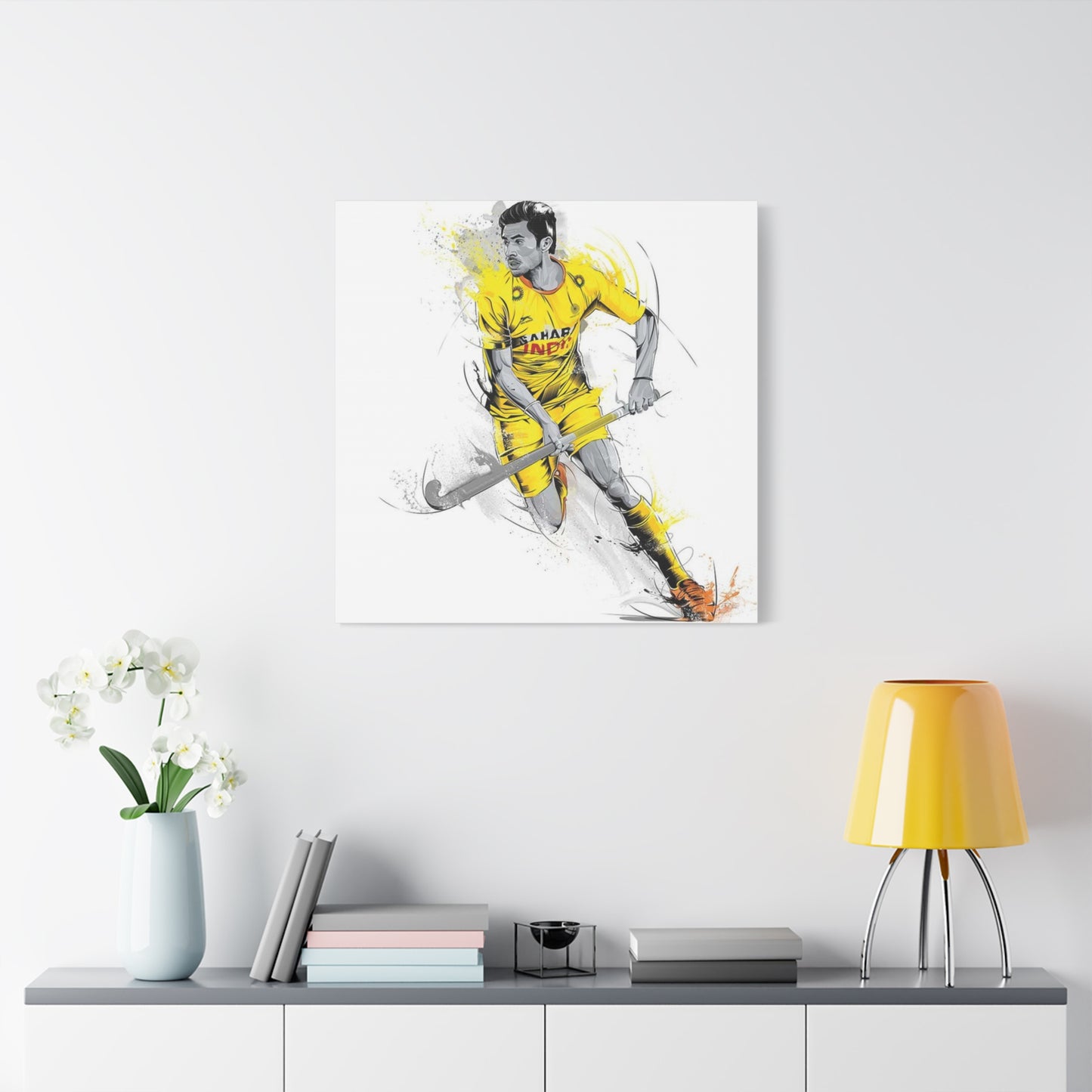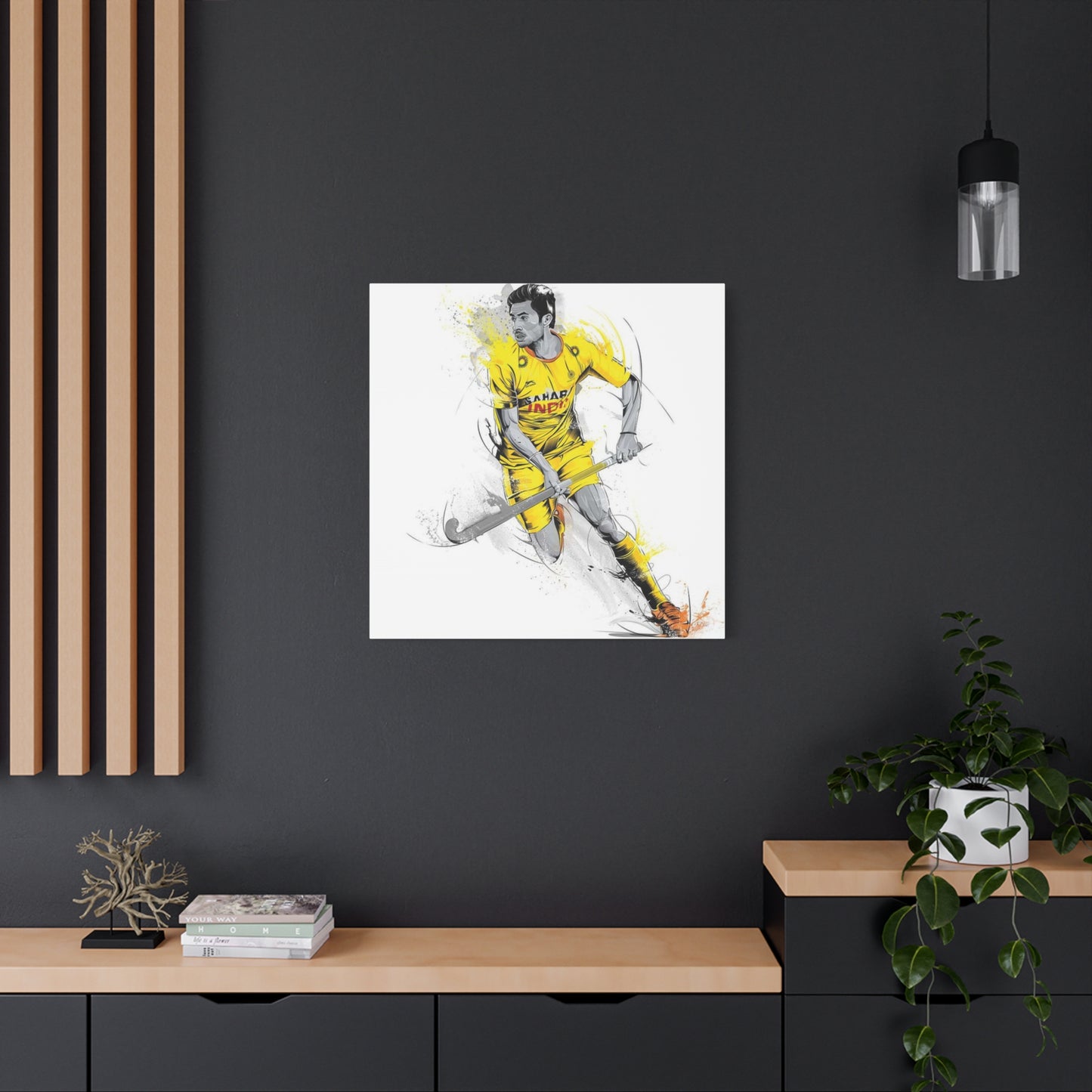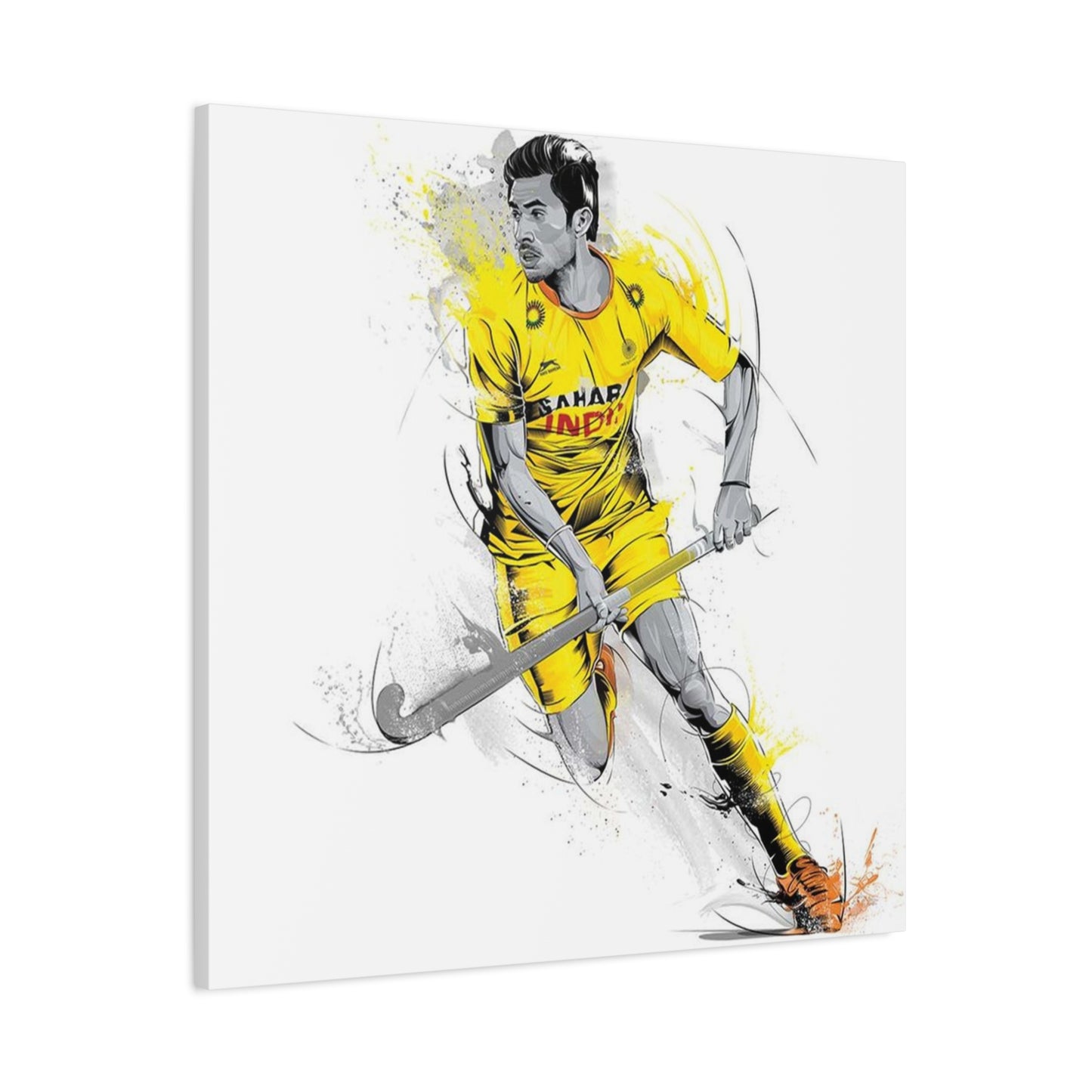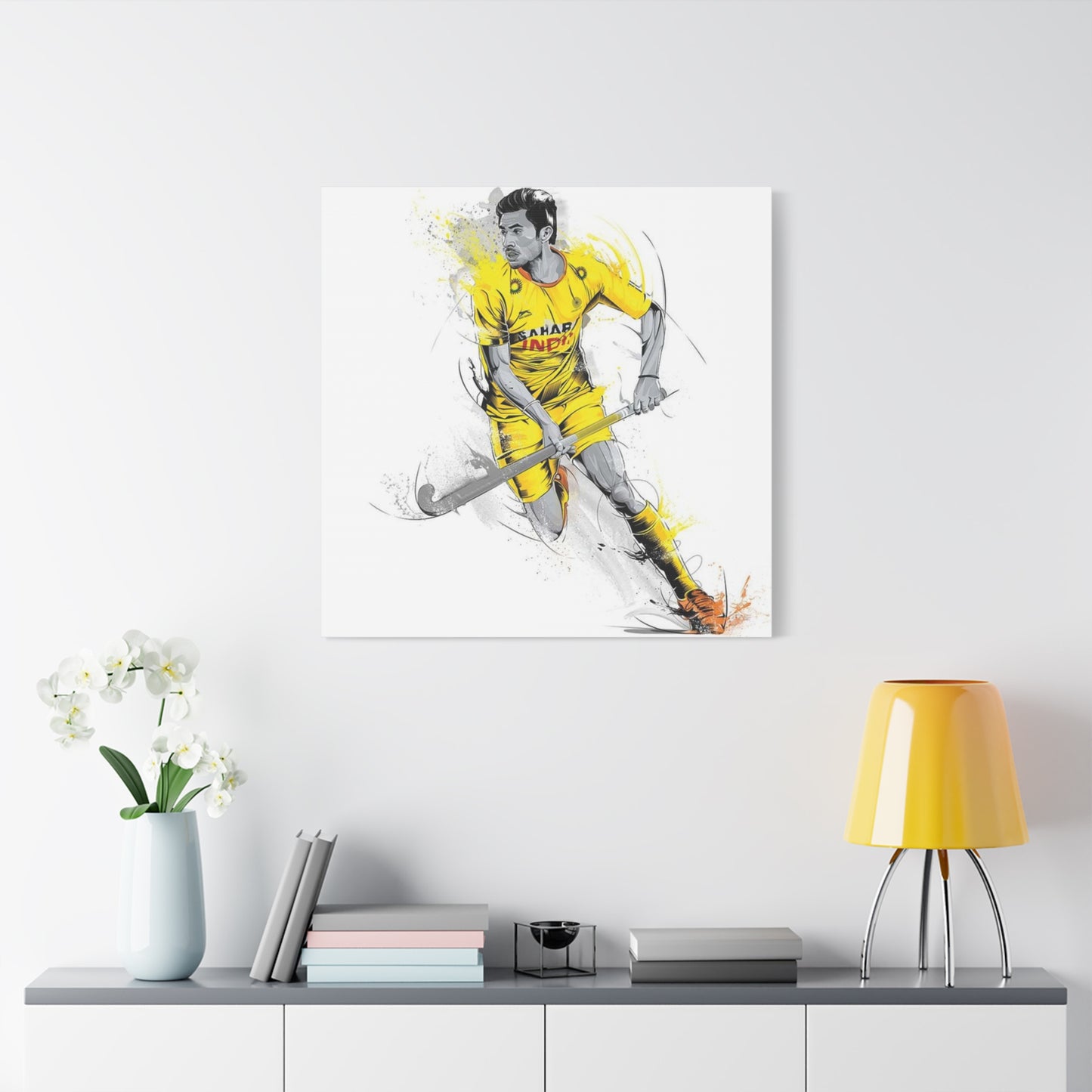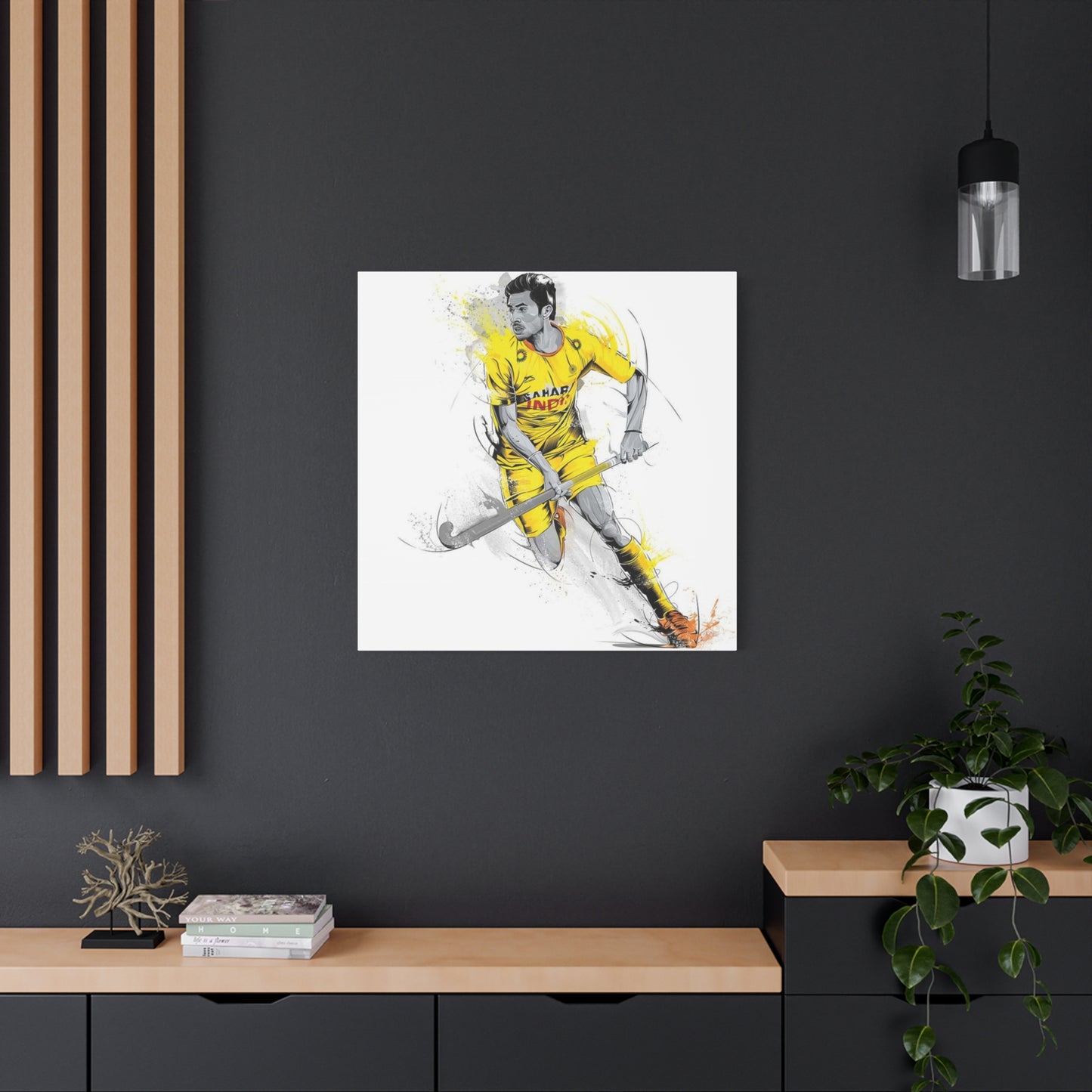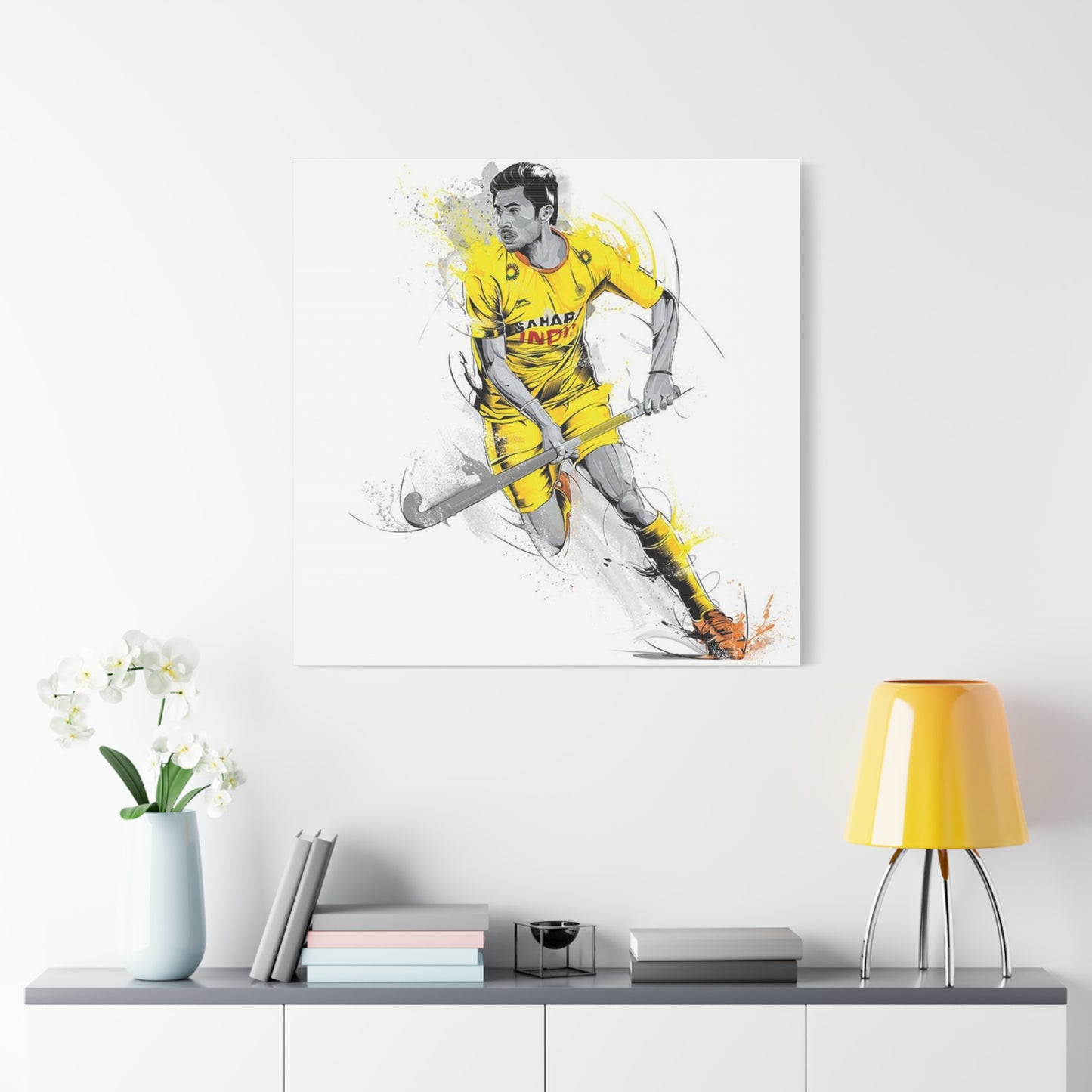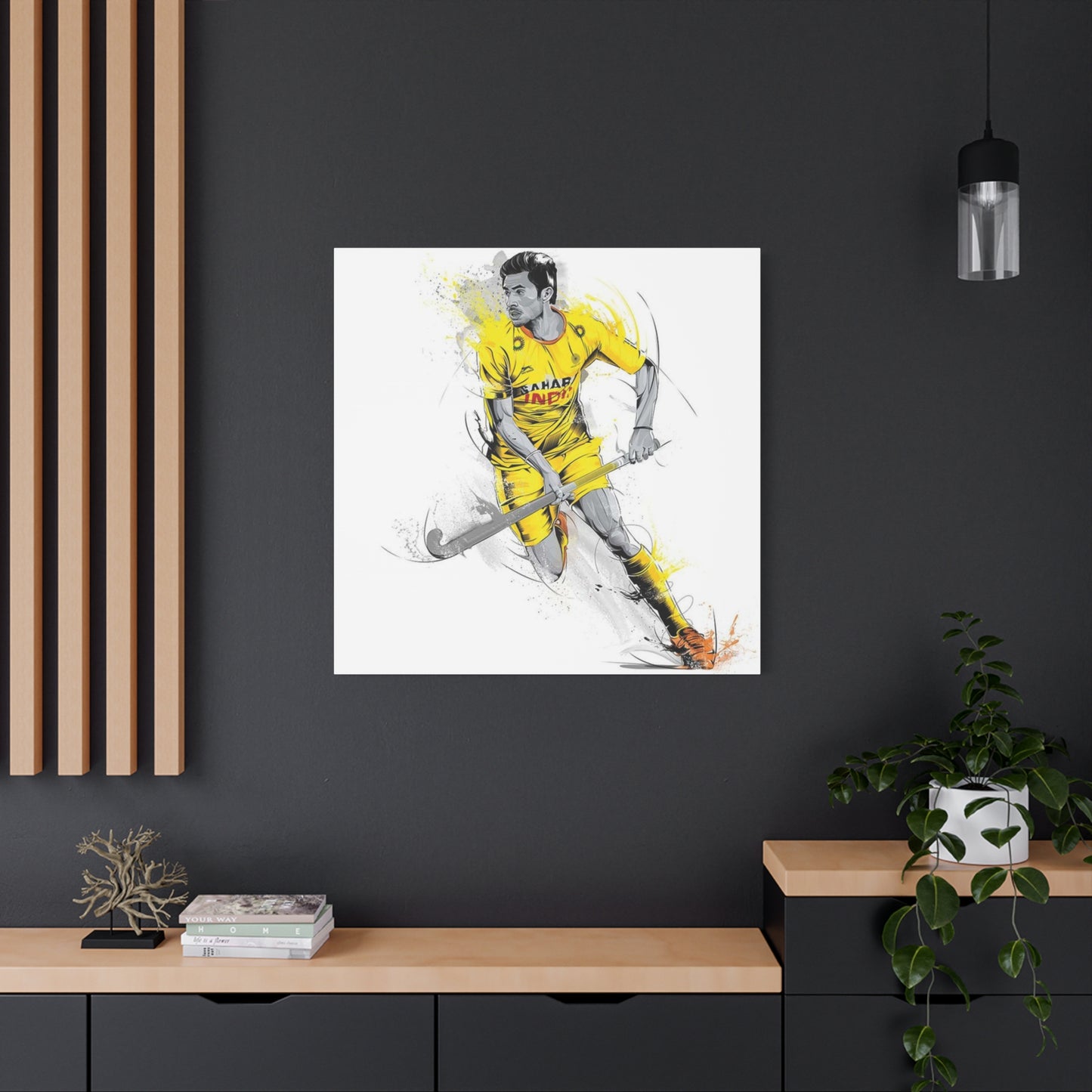Custom Indian Hockey Player Wall art Portraits: A Unique Gift for Sports Fans
Indian hockey player painting wall art represents a powerful intersection of sports heritage, artistic expression, and national identity. These decorative pieces capture the essence of India's rich hockey legacy, transforming ordinary living spaces into galleries that honor the dedication, skill, and triumphs of athletes who have brought glory to the nation. Wall art featuring hockey players serves multiple purposes beyond mere decoration, acting as inspirational focal points that remind viewers of perseverance, teamwork, and the pursuit of excellence. From vintage depictions of legendary matches to contemporary abstract interpretations, hockey-themed wall paintings offer diverse aesthetic options for sports enthusiasts, collectors, and anyone passionate about celebrating Indian sporting achievements.
Significance of Hockey in Indian Sports Culture
Hockey holds a distinguished position in Indian sporting history that few other games can match. The sport became synonymous with Indian excellence during the early twentieth century when the national team dominated international competitions with unprecedented consistency. Between the years spanning from the first Olympic participation to the golden era of victories, Indian hockey players demonstrated technical superiority and tactical brilliance that left opponents struggling to compete. The game was not merely a sport but became a symbol of national capability during times when the country was establishing its identity on the global stage. Wall art depicting hockey players from this era captures more than athletic moments; it preserves visual documentation of periods when sports became intertwined with national pride and collective achievement.
Artists who create paintings featuring Indian hockey players often draw inspiration from historical photographs, match footage, and documented accounts that describe the intensity and skill displayed during these formative years. The emotional resonance of these artworks stems from their connection to real events that shaped sporting consciousness across generations. Families who display such paintings often have personal connections to the sport, whether through direct participation, passionate viewership, or simply appreciation for the cultural significance hockey maintains within Indian society. The visual representation of hockey players in action serves as a bridge between past glories and contemporary aspirations, reminding younger generations of the standards set by their predecessors while inspiring them to pursue similar excellence in whatever fields they choose.
Artistic Styles in Hockey Player Wall Paintings
The diversity of artistic approaches available for creating Indian hockey player painting wall art ensures that collectors and enthusiasts can find pieces matching their aesthetic preferences and interior design requirements. Realistic portraiture captures the authentic likeness of famous players, rendering their features, expressions, and body language with photographic accuracy. These detailed works often focus on individual athletes in moments of concentration or triumph, allowing viewers to connect personally with the subject. Abstract interpretations take a different approach, using shapes, colors, and dynamic compositions to convey the energy and movement inherent in hockey without strictly representational imagery. Such pieces work particularly well in modern interior settings where bold visual statements complement minimalist design philosophies. Impressionistic styles blend both approaches, maintaining recognizable human forms while employing loose brushwork and vibrant color palettes that emphasize emotion over precise detail.
Action-focused paintings capture the kinetic energy of gameplay, showing players mid-stride, stick raised, or celebrating victory with teammates. These dynamic compositions bring excitement and vitality to spaces, making them ideal for entertainment areas, home gyms, or youth bedrooms where motivation and energy are desired atmospheric qualities. Vintage-inspired artwork deliberately mimics the aesthetic qualities of older photographs and posters, using sepia tones, weathered textures, and retro typography to evoke nostalgia for hockey's golden age. Collectors particularly appreciate these pieces for their ability to transport viewers mentally to specific historical periods. Contemporary digital art offers yet another avenue, with artists using graphic design software to create stylized representations featuring bold outlines, flat color fields, and modern compositional techniques that appeal to younger demographics. The choice of artistic style significantly impacts how the painting integrates with existing decor and the emotional response it generates from viewers.
Famous Indian Hockey Players Featured in Wall Art
Certain Indian hockey players have achieved such legendary status that their images frequently appear in wall art collections dedicated to the sport. These athletes transcended their roles as mere players to become cultural icons whose achievements inspired entire generations. Early pioneers who led teams to multiple consecutive victories established templates for excellence that subsequent players strived to match. Their distinctive playing styles, leadership qualities, and clutch performances in crucial matches made them ideal subjects for artistic representation. Midfield maestros known for their exceptional stick work and strategic vision appear in paintings that capture their characteristic poses and expressions of concentration. Goalkeepers whose reflexes and positioning saved countless matches earn representation in artwork highlighting their defensive prowess and mental fortitude under pressure. Forward players celebrated for their goal-scoring abilities feature prominently in dynamic action scenes showing them breaking through defensive lines or executing perfect strikes.
Coaches and mentors who shaped winning teams also appear in commemorative pieces, often shown in contemplative poses or animated discussions with players. The selection of which players to feature in wall art often reflects regional preferences, with certain states and cities showing particular pride in athletes who originated from their areas. Artists commissioned to create hockey player paintings frequently research their subjects extensively, studying match footage, reading biographical accounts, and sometimes interviewing the players themselves to ensure authentic representation. This attention to accuracy honors the athletes while providing educational value to viewers who may learn about specific players and their contributions through extended observation of the artwork. Limited edition prints featuring famous players become valuable collectibles, with signed versions commanding premium prices in the sports memorabilia market. The ongoing creation of new artwork featuring contemporary players ensures that the tradition of celebrating hockey excellence through visual art continues to evolve and remain relevant to current audiences.
Color Schemes and Their Emotional Impact in Hockey Art
Color selection in Indian hockey player painting wall art profoundly influences the emotional atmosphere created within display spaces and the psychological responses evoked in viewers. The tricolor combination of saffron, white, and green immediately connects hockey player paintings to Indian national identity, making these hues popular choices for patriotic-themed artworks. Warm color palettes dominated by reds, oranges, and yellows generate feelings of energy, passion, and excitement that align perfectly with the dynamic nature of competitive sports. These vibrant schemes work exceptionally well in entertainment spaces, home gyms, or youth rooms where stimulating atmospheres are desired. Cool color schemes featuring blues, greens, and purples create calmer, more contemplative moods suitable for professional office environments, meditation spaces, or bedrooms where relaxation takes priority. Monochromatic approaches using variations of a single hue produce sophisticated, cohesive appearances that integrate seamlessly with minimalist interior design philosophies.
Black and white or sepia-toned paintings evoke historical authenticity and timeless elegance, particularly effective for vintage-themed hockey art celebrating earlier eras of the sport. Complementary color combinations placing hues opposite each other on the color wheel create maximum visual contrast and vibrancy, ensuring paintings command attention even in visually busy environments. Analogous schemes using colors adjacent on the wheel produce harmonious, pleasing compositions that feel naturally balanced and comfortable to observe over extended periods. The psychological associations of specific colors influence their appropriateness for different contexts; for instance, gold tones suggest achievement and prestige, making them ideal for commemorative pieces honoring championship victories or legendary player careers. Background color choices affect how prominently the hockey player figure stands out, with neutral backgrounds directing focus to the subject while colorful settings provide additional narrative context. Lighting conditions in display locations should inform color selection, as natural daylight reveals subtle color variations differently than artificial lighting, and certain pigments may appear more vibrant or muted depending on light quality and intensity.
Framing Options for Hockey Player Wall Art
Proper framing enhances the presentation of Indian hockey player painting wall art while providing essential physical protection that preserves artwork integrity over time. Traditional wooden frames offer classic elegance with options ranging from simple, narrow profiles to ornate, wide moldings with decorative carving or gilding. Wood species selection affects both aesthetic appearance and durability, with hardwoods like oak, walnut, and mahogany providing substantial, long-lasting frames that complement formal interior settings. Stained finishes in various tones allow coordination with existing furniture and architectural woodwork, while painted frames in colors matching or contrasting with the artwork create intentional design statements. Metal frames constructed from aluminum or steel present contemporary, minimalist aesthetics particularly suited to modern interior styles. These frames typically feature clean lines, slim profiles, and finishes including brushed aluminum, polished chrome, matte black, or colored powder coatings.
Floating frame designs create the illusion that canvas-mounted paintings hover within the frame structure, producing sophisticated, gallery-quality presentations that work especially well with modern and abstract hockey player artworks. Shadow box frames provide dimensional depth, separating the artwork from the backing with spacers that create actual shadows around the piece, adding architectural interest to flat paintings. This approach proves particularly effective for textured or mixed-media works where dimensional elements deserve emphasis. Frame width selection should consider the artwork size and visual weight, with larger paintings generally requiring proportionally wider frames to provide adequate visual grounding without being overwhelmed. Matting options add another design layer, with paper or fabric mats creating borders between the artwork and frame that can dramatically affect visual presentation. Multiple mat layers in coordinating colors add depth and sophistication while allowing color coordination with both the painting and surrounding decor. Glazing choices protect artwork surfaces from dust, physical contact, and environmental pollutants, with options including standard glass, non-reflective glass, acrylic, and museum-grade UV-filtering materials that prevent light-induced color fading. Frame style should complement rather than compete with the artwork, supporting the painting's visual impact without drawing attention away from the primary subject matter.
Placement Strategies for Maximum Visual Impact
Strategic placement of Indian hockey player painting wall art maximizes its decorative effectiveness and ensures appropriate integration within the broader interior design scheme. Living room focal walls provide ideal locations for significant hockey player paintings, particularly above seating arrangements where artwork becomes a natural conversation piece visible to family and guests. The painting's lower edge should typically sit approximately six to twelve inches above furniture backs, creating visual connection without awkward gaps or excessive height that forces uncomfortable viewing angles. Dining room walls offer excellent display opportunities where artwork can be appreciated during meals and gatherings, with appropriately themed hockey player paintings contributing to the room's atmospheric character.
Hallway corridors benefit from gallery-style arrangements featuring multiple hockey-themed pieces arranged in linear sequences that guide movement through the space while celebrating various aspects of the sport. Bedroom placement depends on the room's function and occupant preferences, with action-oriented hockey paintings providing motivational energy suitable for personal gyms or study areas, while calmer, more contemplative pieces work better for primary sleeping quarters. Home office environments can incorporate hockey player wall art that reflects professional interests while maintaining appropriately serious atmospheres, with framed paintings lending credibility and personality to video conference backgrounds. Stairwell walls present unique opportunities for vertical or stepped arrangements that follow the ascending or descending line created by the stairs themselves, creating dynamic visual movement that complements the physical motion of climbing.
Entertainment spaces including game rooms, home theaters, and bars naturally accommodate sports-themed artwork, with hockey player paintings reinforcing recreational atmospheres and personal interests. Children's bedrooms and play areas benefit from hockey wall art that inspires athletic interest and provides positive role models, though placement height should account for young viewers' sightlines. Lighting significantly affects artwork visibility and impact, with dedicated picture lights, track lighting, or strategically positioned spotlights ensuring paintings remain visible and visually striking during evening hours. Natural light consideration is essential, as direct sunlight can cause irreversible color fading over time, requiring either strategic placement away from windows or use of UV-filtering glazing and window treatments. The relationship between artwork and architectural features including door frames, windows, built-in shelving, and crown molding affects visual balance, with paintings ideally centered on wall sections or aligned with key architectural elements.
Commission Process for Custom Hockey Player Portraits
Commissioning custom Indian hockey player painting wall art allows patrons to obtain unique pieces tailored to specific preferences, subject matter, and spatial requirements. The process typically begins with initial consultations where artists discuss the client's vision, intended display location, size requirements, color preferences, and any specific players or moments to be depicted. Reference materials play a crucial role in commission success, with clients providing photographs, videos, or detailed descriptions of desired subjects, composition arrangements, and stylistic approaches. Professional artists may request multiple reference images from various angles to ensure accurate representation of players, equipment details, and environmental contexts. Budget discussions establish financial parameters early in the process, with pricing typically reflecting factors including artwork dimensions, medium complexity, artist experience and reputation, and project timeline.
Detailed written agreements protect both parties by specifying deliverables, dimensions, materials, deadlines, payment schedules, revision policies, and shipping or delivery arrangements. Many artists create preliminary sketches or digital mockups for client approval before beginning final artwork production, allowing compositional adjustments and subject matter refinements without wasting time or materials. This approval stage ensures alignment between artist interpretation and client expectations, preventing disappointment upon project completion. Production timelines vary considerably based on artwork complexity, artist availability, and medium characteristics, with detailed oil paintings potentially requiring several months while digital artworks or prints may be completed within weeks. Communication throughout the creation process helps maintain client engagement and allows mid-project feedback if the artist offers progress updates.
Some artists document their creation process through photographs or videos that provide interesting behind-the-scenes content clients appreciate receiving alongside completed artworks. Final delivery includes proper packaging to prevent transit damage, with rolled canvases, flat crating, or specialized art shipping boxes protecting the investment. Commission agreements should clarify intellectual property rights, specifying whether artists retain reproduction rights for portfolio use, print sales, or future exhibitions, versus exclusive ownership transferring entirely to the client. Payment structures commonly involve deposits securing the commission slot, progress payments at designated milestones, and final payments upon completion and approval. Building positive relationships with talented artists can lead to ongoing collaborations for additional pieces, with established working relationships streamlining future projects through mutual understanding of preferences and expectations.
Hockey Player Wall Art in Commercial Spaces
Commercial environments including sports bars, restaurants, hotels, corporate offices, and retail establishments utilize Indian hockey player painting wall art to create distinctive atmospheric qualities that enhance customer experiences and reinforce brand identities. Sports-themed hospitality venues particularly benefit from authentic hockey artwork that establishes credibility with knowledgeable patrons while creating visually engaging environments that encourage extended visits. Restaurant walls featuring hockey player paintings provide conversation material for diners, contributing to the overall dining experience through visual interest that complements food and service quality. The selection of specific players or artistic styles can target particular demographic groups, with vintage hockey artwork appealing to older patrons nostalgic for earlier eras while contemporary graphic interpretations attract younger customers.
Hotel lobbies and guest room corridors incorporate locally relevant artwork including hockey player paintings when properties wish to celebrate regional sports heritage or appeal to traveling sports enthusiasts. Corporate offices of companies sponsoring hockey teams, manufacturing sports equipment, or operating within the broader sports industry appropriately display hockey-themed artwork that visually communicates organizational values and business focus. Reception areas featuring impressive hockey player paintings make strong first impressions on visiting clients, suggesting professionalism, attention to detail, and alignment with values of excellence and achievement. Conference rooms and meeting spaces can incorporate motivational hockey imagery that subtly reinforces messages about teamwork, strategic thinking, and competitive success relevant to business contexts. Retail environments selling sports equipment, athletic apparel, or collectibles naturally showcase hockey player artwork that reinforces product categories and appeals to target customer demographics.
Fitness facilities including gyms, training centers, and sports medicine clinics use hockey player paintings as motivational elements encouraging patrons toward their physical development goals. Educational institutions from elementary schools through universities display hockey artwork celebrating institutional athletic programs and inspiring student participation in organized sports. Healthcare facilities occasionally incorporate sports-themed artwork in waiting areas, therapy rooms, or rehabilitation centers where the positive, energetic character of hockey imagery contributes to healing-supportive environments. Commercial artwork selection requires consideration of factors beyond aesthetic preference, including potential for offense, cultural sensitivity, maintenance requirements in high-traffic settings, and alignment with overall brand messaging strategies.
Digital Reproduction versus Original Artwork
The distinction between digital reproductions and original Indian hockey player painting wall art involves important considerations affecting aesthetic quality, investment value, and purchasing decisions. Original paintings represent unique creations produced directly by artists through manual application of paint to substrate surfaces, with each brushstroke, color mixture, and textural element being physically created during the artwork's production. These one-of-a-kind pieces carry intrinsic value derived from their uniqueness, the artist's direct involvement in their creation, and the impossibility of exact duplication. Original paintings display subtle surface qualities including texture variation, brushstroke visibility, and dimensional paint applications that cannot be perfectly reproduced through photographic or scanning processes. Digital reproductions utilize high-resolution photography or scanning to capture images of original artworks or create entirely digital compositions, then employ printing technologies to transfer these images onto various substrates.
Quality reproduction processes including giclée printing produce visually impressive results with excellent color accuracy and detail resolution suitable for most decorative purposes, though careful examination reveals their printed nature through lack of surface texture and evidence of mechanical dot patterns. Limited edition reproductions numbered and signed by artists occupy a middle ground between mass-produced prints and unique originals, carrying modest investment potential while remaining accessible to broader audiences. The ethical considerations surrounding reproductions require artists or copyright holders to authorize production, with unauthorized reproductions constituting theft of intellectual property. Pricing differences between originals and reproductions reflect their relative scarcity and investment potential, with originals commanding prices ranging from hundreds to hundreds of thousands of dollars while quality reproductions typically cost between tens and several hundred dollars.
Display contexts influence whether original or reproduction artwork makes more practical sense, with high-security environments or prestigious collections demanding originals while casual residential or commercial spaces function perfectly well with quality reproductions. Some collectors build extensive reproduction collections allowing them to enjoy diverse artwork without the financial commitment required for original paintings, accepting the investment limitations in exchange for decorative flexibility and affordability. Transparency in artwork marketing prevents consumer deception, with sellers obligated to clearly disclose whether pieces are original paintings, artist-authorized reproductions, or mass-produced prints. Authentication concerns arise primarily with original works, where forgeries and misattributions can defraud unsuspecting buyers, while reproductions mainly risk quality variations when produced through substandard processes or materials.
Cultural Significance and National Identity
Indian hockey player painting wall art connects to broader themes of cultural identity, national pride, and collective memory that extend far beyond simple sports fandom. Hockey's historical role as a source of international recognition for India during the early decades following independence imbued the sport with symbolic significance representing the young nation's capability and potential. Victories achieved on international stages provided tangible evidence of Indian excellence that countered colonial-era narratives suggesting inherent inferiority, making hockey triumphs psychologically important beyond their sporting significance. The dominance displayed during multiple consecutive championship wins created lasting cultural memory of a period when Indian athletes set global standards rather than struggling to match them. Wall art depicting hockey players from these golden eras serves as visual reminder of this exceptional period, keeping alive historical knowledge that might otherwise fade as generations pass.
Contemporary efforts to revive Indian hockey's competitive standing draw emotional motivation from this storied past, with references to historical greatness providing both inspiration and burden for current players. The display of hockey player paintings in public spaces, educational institutions, and government buildings makes visual statements about valued national achievements and heroes worthy of commemoration. Regional variations in hockey enthusiasm create geographic patterns in the popularity of hockey-themed artwork, with certain states showing particularly strong connection to the sport's history and culture. The inclusion of hockey imagery alongside other national symbols in artistic compositions reinforces the sport's position within the broader constellation of elements defining Indian identity.
Generational transmission of sports enthusiasm occurs partly through continued visibility of sports heroes in visual culture, with displayed artwork exposing young people to athletes who might otherwise be forgotten. The commercial market for hockey player paintings reflects the sport's cultural position, with robust demand indicating continued public interest while weak markets might suggest declining relevance. Critical discussions about national sports priorities, funding allocations, and media coverage occasionally reference hockey's historical prominence, using past success as argument for renewed investment. The emotional responses viewers experience when encountering powerful hockey player artwork connect to deeper feelings about national capability, pride in achievement, and desire for continued success that transcends sports into broader aspirations for national development.
Photography Integration in Hockey Player Paintings
Many artists creating Indian hockey player painting wall art incorporate photographic elements or base their compositions on photographic references, creating interesting relationships between these distinct visual media. Reference photography provides accurate anatomical information, lighting studies, and compositional ideas that inform realistic painting development, with artists typically working from multiple photographs capturing subjects from various angles and in different lighting conditions. Photo-realistic painting styles deliberately attempt to replicate photographic characteristics including precise focus, accurate perspective, and naturalistic lighting, producing paintings visually similar to photographs but created through manual paint application. Mixed media approaches physically incorporate printed photographs into painted compositions through collage techniques, creating textural variation and conceptual dialogue between mechanical reproduction and handcrafted artistic expression.
Digital manipulation of photographs before using them as painting references allows artists to adjust compositions, lighting, colors, and elements to create idealized arrangements impossible to achieve through single-photograph capture. The debate regarding photographic dependence questions whether paintings derived directly from photographs demonstrate equivalent creativity and skill compared to works composed through direct observation or imagination. Historical hockey photographs documenting matches, players, and moments from earlier eras provide essential reference material for artists depicting subjects predating their personal experience or available contemporary documentation. Action photography freezing motion at impossible-to-see millisecond intervals reveals body positions and movement characteristics that inform dynamic painting compositions, with high-speed photography particularly valuable for capturing athletic motion.
Copyright considerations require artists to either take their own reference photographs, use images from public domain sources, obtain explicit permissions from photographers, or sufficiently transform borrowed imagery through substantial creative modification. Photo transfer techniques physically move photographic images onto painting surfaces through chemical or mechanical processes, creating foundations for subsequent paint application that combines photographic and painterly qualities. Tonal studies converting color photographs to black and white help artists understand value relationships independent of color information, improving their ability to create convincing three-dimensional form through light and shadow. Grid methods for transferring photographic compositions onto larger painting surfaces provide mechanical accuracy in proportion and placement, though purists sometimes view these techniques as less skillful than freehand drawing. Digital painting executed on tablets or computers blurs distinctions between photography and painting, allowing artists to work directly over photographic bases while maintaining complete creative control and unlimited revision capability.
Emotional Connections to Specific Players
Indian hockey player painting wall art featuring particular athletes often reflects deep emotional connections between viewers and those individuals based on inspirational stories, memorable performances, or personal encounters. Legendary players who led teams through multiple championship victories become cultural heroes whose images carry associations with national pride, excellence, and determination that transcends their specific athletic achievements. Comeback stories describing athletes overcoming serious injuries, personal tragedies, or career setbacks to return successfully to competition resonate emotionally with viewers facing their own adversities and seeking inspiration for perseverance. Underdog narratives celebrating players who exceeded expectations despite lacking advantages enjoyed by competitors create particularly strong emotional bonds, as these stories validate the potential for determination and effort to overcome circumstantial limitations.
Local heroes originating from viewers' home regions create special connections based on geographic pride and identification, with families sometimes displaying artwork featuring players from their specific cities, towns, or neighborhoods. Generational transmission occurs when parents introduce children to players they admired during their own youth, creating family traditions of appreciation for particular athletes and their artistic representation. Personal encounter stories describing meetings with depicted players, whether through chance encounters, organized events, or family connections, imbue artwork with enhanced sentimental value beyond artistic or investment considerations. Playing style preferences lead viewers to particularly appreciate players whose approaches to the game match their own values regarding sportsmanship, aggression, creativity, or teamwork, making artistic representations of those individuals especially meaningful.
Leadership qualities demonstrated through captaincy, mentorship, or example set for teammates resonate with viewers who value similar characteristics in their own professional or personal spheres. Retirement tributes honoring players concluding their competitive careers provide closure while celebrating accumulated achievements, with commemorative artwork serving as permanent recognition of contributions spanning years or decades. Controversial figures who generated strong opinions through behavior, statements, or playing tactics create complex emotional responses reflected in artwork depicting them, with some viewers celebrating rebelliousness while others reject representation of individuals they view negatively. Record-breaking performances capturing specific achievements such as highest goal totals, longest winning streaks, or unprecedented tournament statistics create objective measures of excellence worthy of artistic commemoration.
Hockey Player Art in Educational Settings
Educational institutions from elementary schools through universities appropriately incorporate Indian hockey player painting wall art into their physical environments to support multiple pedagogical objectives while creating inspiring spaces for students and staff. Athletic facilities including gymnasiums, training rooms, and locker areas naturally accommodate hockey player artwork that reinforces the value placed on physical education and competitive sports within the institutional culture. Hallway displays featuring accomplished alumni who achieved hockey success create pride in institutional heritage while providing current students with concrete examples of achievement possible through participation in school programs. Classroom spaces dedicated to physical education instruction, health topics, or sports history courses benefit from relevant imagery that visually supports curriculum content and maintains thematic coherence.
Library and study areas might display hockey player artwork as part of broader recognition of diverse achievement forms, balancing academic emphasis with acknowledgment that excellence manifests through various paths including athletic pursuits. Common areas where students congregate during breaks including cafeterias, lounges, and auditorium lobbies create opportunities for casual artwork engagement that gradually builds familiarity and appreciation through repeated exposure. Administrative offices housing athletic directors, coaches, and physical education coordinators appropriately display hockey player paintings reflecting departmental focus while creating professional environments that honor the sport. Awards displays combining trophies, plaques, and photographs with complementary hockey player paintings create comprehensive recognition installations celebrating institutional athletic achievements.
Motivational installations pairing inspirational quotations with hockey player imagery create encouragement zones supporting students through academic and personal challenges by reminding them of values including perseverance, teamwork, and dedication. Recruitment spaces where prospective students and families tour facilities use hockey player artwork to showcase institutional commitment to athletics and communicate that sports participation is valued and supported. Museum-style exhibitions temporarily displaying collections of hockey player artwork provide educational programming opportunities exploring topics including sports history, artistic technique, or the intersection of athletics and cultural identity. Interactive installations allowing students to create their own hockey-themed artwork guided by displayed professional examples combine art education with sports appreciation while developing creative skills.
Color Theory Applications in Hockey Artwork
Sophisticated application of color theory principles significantly enhances the visual impact and emotional effectiveness of Indian hockey player painting wall art through strategic hue selection, value control, and saturation management. Primary color schemes featuring red, blue, and yellow create bold, energetic compositions with clear visual hierarchy through selective emphasis of particular hues within the triad. Secondary and tertiary colors expand palette options while maintaining color harmony through systematic relationships based on color wheel positions and mixing principles. Complementary contrast placing opposite wheel colors adjacent creates maximum visual intensity and vibration, making focal areas command attention while less critical elements recede through proximity to less contrasting combinations. Analogous harmony using neighboring wheel colors produces cohesive, naturally pleasing compositions without the aggressive tension of complementary schemes, suitable for contemplative or sophisticated hockey player portraits. Triadic arrangements utilizing three equidistant wheel positions balance visual interest with harmony, providing sufficient variety without chaotic randomness while maintaining fundamental unity.
Split complementary modifications replacing direct opposites with adjacent hues reduce intensity while preserving contrast, offering compromise between harmonious analogous schemes and aggressive complementary approaches. Value contrast between light and dark elements creates visual clarity and dimensional illusion regardless of hue relationships, with strong value patterns ensuring compositions read effectively even in monochrome reproduction. High-key paintings dominated by light values communicate airiness, optimism, and energy appropriate for celebratory hockey moments or aspirational themes, while low-key approaches emphasizing dark values suggest drama, intensity, and gravitas. Saturation control determines color intensity from vibrant pure hues to neutralized grays, with varied saturation creating visual interest through contrast between vivid focal areas and subdued supporting elements.
Color temperature psychology associates warm hues with energy, aggression, and excitement while cool colors suggest calmness, strategy, and control, allowing artists to support narrative content through strategic temperature choices. Local color accuracy reproducing actual object hues creates realism and recognizability, ensuring viewers immediately identify uniforms, equipment, and environmental elements. Expressive color liberation from literal accuracy supports emotional communication or stylistic unity, with artists sometimes dramatically altering natural colors for compositional or psychological effect. Atmospheric perspective utilizing cooler, lighter, less saturated colors for distant elements creates convincing spatial depth by mimicking natural optical effects in outdoor environments. Color symbolism in Indian cultural context including saffron representing courage, white suggesting peace, and green symbolizing fertility allows color choices to carry cultural meaning beyond aesthetic considerations.
Evolution of Hockey Art Styles Over Decades
The stylistic evolution of Indian hockey player painting wall art reflects broader art historical movements, changing aesthetic preferences, and technological developments across decades spanning from early sports documentation to contemporary digital approaches. Early twentieth century representations often employed realistic academic styles influenced by British colonial art education systems, with formal portraits and commemorative paintings documenting significant players and matches through conventional techniques. Mid-century modernist influences introduced progressive simplification, abstraction, and emphasis on formal qualities over literal representation, with some hockey player artworks exploring how the sport's dynamic movement and energy could be captured through non-representational means. Pop art movements of later decades inspired bright, graphic hockey player representations incorporating commercial imagery, bold outlines, and flat color areas that referenced mass media aesthetics and consumer culture.
Photorealism emerging as a technical movement challenged artists to achieve unprecedented accuracy and detail, with some hockey player paintings becoming virtually indistinguishable from photographs through painstaking reproduction of visual information. Expressionistic approaches prioritizing emotional intensity over accurate representation created hockey player artworks using exaggerated features, distorted proportions, and aggressive brushwork conveying the psychological dimensions of competitive athletics. Street art and graffiti aesthetics emerging from urban visual culture introduced spray paint techniques, stencil methods, and layered imagery combining text and image into hockey player artworks reflecting contemporary popular visual language. Digital illustration tools expanded creative possibilities through features including unlimited color palettes, easy revision, special effects, and hybrid approaches combining painted and digital elements.
Vector art techniques creating imagery from mathematical curves rather than pixels enabled graphic hockey player representations with clean edges, scalable dimensions, and contemporary minimalist sensibilities. Mixed media explorations combining traditional painting with collage, assemblage, found objects, and unconventional materials reflected broader contemporary art trends questioning medium boundaries and definitions. Neo-traditional movements consciously reviving classical Indian artistic styles applied historical techniques to contemporary hockey subject matter, creating culturally hybrid artworks honoring heritage while addressing current interests. Installation and environmental art occasionally incorporated hockey themes into larger immersive experiences beyond conventional framed paintings, with murals and public artworks bringing hockey player imagery into shared community spaces.
Sourcing Authentic Hockey Player Artwork
Collectors seeking quality Indian hockey player painting wall art must navigate diverse acquisition channels each offering distinct advantages, risks, and appropriate selection criteria for particular circumstances and objectives. Established art galleries specializing in sports-themed or contemporary Indian artwork provide curated selections, expert guidance, and authentication assurances that justify their premium pricing and commission structures. Emerging online galleries and virtual exhibition spaces expand access beyond geographic limitations while reducing overhead costs that translate to competitive pricing, though physical inspection before purchase becomes impossible. Artist direct purchases through studio visits, personal websites, or social media platforms eliminate intermediary costs while establishing relationships enabling commissioned work and providing maximum financial support to creators. Art fairs and exhibitions gathering multiple artists and galleries in temporary events create opportunities for comparative shopping, discovering new artists, and occasionally negotiating favorable pricing during or after events.
Auction houses handle significant artworks entering secondary markets through estate sales or collection liquidations, with established auction results providing transparent pricing information though buyer premiums increase final costs. Antique markets and vintage dealers occasionally stock older hockey player artworks that may represent historical interest or undervalued acquisition opportunities for knowledgeable collectors who recognize quality. Online marketplaces including generalized e-commerce platforms present vast inventory at varying quality levels, requiring careful evaluation of seller reputation, artwork condition reports, and return policies before committing to purchases. Print-on-demand services offer affordable reproductions of hockey player imagery, suitable for decorative purposes though lacking investment value or collector appeal.
Sports memorabilia dealers sometimes carry artwork alongside equipment, photographs, and signed items, with crossover appeal to collectors interested in comprehensive hockey-related holdings. Interior designers and art consultants provide personalized selection services matching artwork to specific spaces and client preferences, with professional expertise justifying service fees for complex or high-value projects. Estate sales and private collection dispersals occasionally present acquisition opportunities when previous owners downsize, relocate, or pass away, with pricing potentially below market levels depending on seller motivations and awareness. Commissioned works through artist agreements create customized pieces perfectly matching specifications, though timelines extend significantly beyond purchasing existing inventory. Authentication verification through expert examination, provenance research, and technical analysis protects against fraud, misattribution, or undisclosed condition issues that could affect value and collectibility.
Preservation for Future Generations
Long-term preservation of Indian hockey player painting wall art requires comprehensive strategies protecting these cultural artifacts so future generations can appreciate both their artistic merit and historical documentation of sporting achievements. Archival mounting and framing materials including acid-free mats, UV-filtering glazing, and chemically stable backing boards prevent gradual deterioration caused by contact with acidic or reactive substances that yellow, embrittle, or stain artwork over decades. Climate control maintaining stable temperature and humidity levels prevents expansion, contraction, and moisture-related damage to canvases, paints, and substrate materials that experience physical stress from environmental fluctuations. Professional conservation assessment by trained conservators identifies existing damage, deterioration risks, and appropriate intervention strategies when artwork shows signs of instability or requires treatment.
Documentation including condition reports, provenance records, exhibition histories, and photographic surveys creates comprehensive knowledge about individual artworks that informs future care decisions and preserves information potentially lost through time. Digital archiving through high-resolution photography, 3D scanning, or detailed written descriptions creates permanent records preserving visual and contextual information even if physical artworks suffer damage or loss. Secure storage for artworks not currently displayed protects them from environmental exposure, physical damage, and security risks while maintaining accessibility for periodic condition checks and rotation into active display. Insurance coverage specifically designed for fine art provides financial protection against loss while policy requirements often mandate minimum conservation standards that enhance long-term survival prospects. Handling protocols including clean glove use, proper support methods, and professional transportation services prevent damage during movement between locations or storage arrangements.
Pest management strategies addressing insects, rodents, and microorganisms that threaten organic art materials protect against biological deterioration that can destroy artworks rapidly once infestations establish. Education ensuring family members, staff, or institutional personnel understand proper care procedures prevents well-intentioned but damaging interventions such as inappropriate cleaning attempts or harmful display conditions. Succession planning for private collections specifies future ownership, care responsibilities, and potential donation to public institutions that ensures artworks receive continued appropriate care rather than being discarded or damaged through neglect. Professional restoration when necessary addresses existing damage through scientifically informed techniques that preserve original materials while returning artworks to stable, displayable conditions without inappropriate overpainting or modernization.
Hockey Player Art as Diplomatic and Cultural Gifts
Indian hockey player painting wall art serves effectively as diplomatic gifts, corporate presents, and cultural exchange items that communicate respect, shared interests, and appreciation while celebrating Indian sporting heritage in international contexts. Government diplomatic missions sometimes present hockey player artwork to foreign dignitaries, cultural institutions, or sister cities as expressions of Indian cultural achievement that transcend language barriers through universal appeal of athletic excellence. Corporate gifting for international business relationships utilizes hockey player paintings as sophisticated presents demonstrating thoughtfulness beyond generic items while subtly communicating organizational values around teamwork, competition, and goal achievement. Cultural exchange programs between Indian institutions and foreign organizations appropriately include hockey player artwork in exhibitions, permanent donations, or loan arrangements that introduce international audiences to Indian sports heritage.
University partnerships exchanging students, faculty, and cultural resources sometimes incorporate hockey player paintings in campus displays celebrating Indian presence and contributions within international academic communities. Sports diplomacy initiatives leveraging athletic connections to build international relationships naturally incorporate hockey-themed artwork as visual representations of shared athletic values and competitive respect between nations. Tourism promotion efforts showcasing Indian culture, achievements, and attractions occasionally feature hockey player artwork in promotional materials, exhibitions, or gift items presenting sports excellence as component of broader national identity. Auction donations of hockey player paintings for charitable fundraising events supporting international causes demonstrate Indian cultural generosity while achieving practical philanthropic objectives through artwork value.
Museum acquisitions by international institutions collecting South Asian art, sports history materials, or contemporary visual culture expand global awareness of Indian hockey achievements and artistic talent. Private collection displays by expatriate communities living abroad maintain cultural connections to Indian heritage while introducing host countries to aspects of Indian sports culture they might not otherwise encounter. Commercial product collaborations incorporating hockey player imagery on consumer goods distributed internationally spread recognition of Indian hockey heritage through marketplace exposure beyond fine art collecting circles. Academic publications analyzing Indian hockey player artwork as cultural artifacts disseminate scholarly understanding of sports intersection with artistic expression, national identity, and visual culture across international research communities.
Enhance Hockey Artwork Display
Proper illumination of Indian hockey players painting wall art dramatically affects visual impact, color perception, and viewer engagement through strategic lighting design that considers both aesthetic presentation and conservation requirements. Natural daylight provides the most accurate color rendering with high color rendering index values approaching perfect reproduction, though uncontrolled sunlight introduces UV radiation risks requiring protective measures including window films, curtains, or UV-filtering glazing. Incandescent lighting produces warm color temperatures around 2700-3000 Kelvin that enhance warm tones in artwork while potentially distorting cool color perception and consuming significant energy compared to modern alternatives. Halogen lamps offer brighter, whiter light than standard incandescent bulbs with improved energy efficiency, though heat production remains a conservation concern requiring adequate distance between light sources and artwork surfaces.
Fluorescent tubes in full-spectrum formulations provide energy-efficient lighting with decent color rendering when quality phosphor coatings ensure balanced spectral output, though earlier generation fluorescents produced harsh, color-distorting illumination unsuitable for artwork display. LED technology revolutionized artwork lighting through minimal UV emission, negligible heat production, exceptional energy efficiency, long lifespan, and increasingly sophisticated color rendering capabilities with CRI values exceeding 95 in premium products. Picture lights mounted directly above or below framed paintings provide dedicated illumination creating dramatic emphasis through focused light pools, with adjustable arms allowing precise positioning to eliminate glare while ensuring even coverage. Track lighting systems offer flexibility for galleries or collections with multiple artworks through adjustable fixtures that can be repositioned as display arrangements change, with beam angle selection determining whether light spreads broadly or focuses narrowly. Recessed ceiling fixtures create clean architectural integration though positioning limitations sometimes compromise optimal artwork illumination unless carefully planned during construction or renovation phases.
Accent lighting using spotlights or wall washers highlights specific artworks within larger spaces, drawing attention through brightness contrast with surrounding ambient lighting levels. Ambient room lighting should remain subdued relative to artwork illumination to maximize visual impact through contrast while preventing eye strain that occurs when viewing bright objects in otherwise dark environments. Dimmable lighting circuits enable adjustment matching different times of day, activities, or moods while providing conservation benefits by reducing light exposure during periods when artwork viewing is incidental rather than primary focus. Color temperature selection between warm, neutral, and cool white LEDs should complement the artwork's inherent color palette, with neutral white around 4000 Kelvin generally providing balanced illumination suitable for diverse artistic styles. Lighting angle significantly affects how surface textures, brushstrokes, and dimensional elements appear, with grazing light emphasizing texture through shadow creation while perpendicular illumination minimizes texture visibility.
Final thoughts
Custom Indian hockey player wall art portraits offer a meaningful way to celebrate both the sport and the spirit of individuality. More than just decorative pieces, these portraits serve as a powerful tribute to a game that has shaped Indian sports culture and inspired countless fans across generations. By transforming an athlete’s passion into a personalized artwork, you’re not only preserving a moment in time but also creating a lasting symbol of pride, dedication, and love for the sport.What makes these portraits so special is the personal touch. Unlike generic sports prints, custom artwork captures the personality, emotion, and unique story of the player—whether it’s a professional athlete, a rising talent, or even someone who plays simply for the love of the game. This personalization turns an ordinary wall into a visual statement, one that reflects strength, determination, and cultural heritage. For sports fans, such a piece can be both inspiring and deeply personal.
These portraits also offer incredible versatility in style. Whether rendered in a realistic, detailed manner or through bold, artistic brush strokes, they can fit seamlessly into any interior design. A sleek black-and-white sketch can bring a touch of sophistication to a modern space, while vibrant, colorful prints can add energy and personality to a room. They work beautifully in living rooms, sports-themed lounges, bedrooms, or even offices—anywhere you want to showcase a passion for the game.Gifting a custom hockey player wall art portrait is particularly special because it’s personal and memorable. Unlike conventional sports merchandise, it carries emotional value. It could celebrate a loved one’s achievements, honor a sporting idol, or commemorate a meaningful moment on the field. For parents, friends, teammates, or fans, receiving such a portrait isn’t just about receiving art—it’s about receiving a story, a piece of their passion immortalized on canvas or print.
Furthermore, custom artwork supports artists who pour their creativity into bringing these portraits to life. Each stroke and detail adds depth, ensuring that no two pieces are ever exactly the same. This uniqueness makes it a thoughtful, one-of-a-kind gift that will be cherished for years.Ultimately, custom Indian hockey player wall art portraits are more than decorations—they are powerful expressions of identity, sportsmanship, and cultural pride. Whether displayed at home, gifted to a loved one, or used to commemorate an unforgettable moment, these portraits embody the strength, skill, and legacy of the sport. For any hockey enthusiast, this is a timeless and meaningful way to keep their passion alive.



















